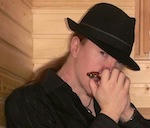harp13
1 post
Dec 01, 2010
3:24 PM

|
Hi Everybody,
I've recently started setting up my harps for overblows. I mean I have done many attempts on my broken harps and decided that I will start setting up my gigging harps as well. The thing is that harps I'm using to do my gigs are mostly Special 20's. I've noticed that they are not as easy to set up as golden melody harps. My question is anybody here who sets up special 20's to overblow playing?? If yes could you give some advice? Or maybe special 20's aren't as overblow friendly as golden melody or it's me only and I should work more and practice my craft first instead of blaming harps????
Thanks
|
GermanHarpist
1911 posts
Dec 01, 2010
3:40 PM

|
Gap them low (especially blow reed), a little embossing helps too.
----------
The MBH thread-thread thread!
|
boris_plotnikov
321 posts
Dec 01, 2010
8:15 PM

|
Heavy full lenght embossing helps much more. BTW greatly embossed harp don't need such a tiny gaps. I emboss harmonicas using microscope now.
----------
Excuse my bad English. Click on my photo or my username for my music.

|
apskarp
356 posts
Dec 01, 2010
8:43 PM

|
I use mainly Special 20's and I set them up to OB. I basically do four things to them and that seems to improve the harps a lot:
1) Embossing
2) Chamfering
3) Tuning
4) Gap adjustment
Wax & nail polish in the rivet ends helps to get the OB's more stable if you have problems with them.
----------

Youtube
Hoodoo Sauna
Blog
|
isaacullah
1266 posts
Dec 01, 2010
10:05 PM

|
I rarely have the time to do a full set up on a harp these days. I've found that simply doing some careful gapping following the procedure set up in Joe Spiers (harpwrench's) video series on gapping vastly helps overblowability on all of my harps, including the Spec 20.
Of course, embossing, flat sanding (of the draw reedplate and of wood combs), etc. will also help, but in my experience, proper gapping gets you 80% of the way there.
Most of my harps are only gapped and flat sanded. In fact, I've currently only got one working harp on which I've done any embossing at all.
----------
--------------------------------------
 View my videos on YouTube!" View my videos on YouTube!"
|
apskarp
357 posts
Dec 02, 2010
3:15 AM

|
Here's a post of mine where I explained in more details my process of customizing the A-harp + the experiences in all of the phases:
Customizing an A-harp
----------

Youtube
Hoodoo Sauna
Blog
|
chromaticblues
352 posts
Dec 02, 2010
7:08 AM

|
Nice work apskarp!
I've been thinking about this, but really haven't come up with a good idea yet. The only thing I can think of (and it kind gets two birds with one stone) is take the reedplate (with feeler gauges wedged under and taped at the end) and polish the whole thing at once with a ploishing wheel and some middle of the road (grit wise) abrassive on a small bench. This would remove the sharp edges and soften the tuning marks at the same time. Maybe?
This is something I'd like to try soon. I just don't have a brench gringer and don't want to buy one then find out thats not as good an idea as I thought.
I do know there must be an exact angle or angles to achieve whatever chamfering does. Its like doing a three angle valve job on an engine! If someone put a harp in a wind tunnel and tested that would be interesting to see the results.
It may make the harp more responsive like you guys say, but think about this: if the top side of the reed is respondible for producing most of the sound then removing and/or cutting angles into the edges of the reeds is going to increase the the surface area that produces the sound, but decrease the straight ahead air movement. That should do a couple things. One it should cut the volume down (very little), increase the duration of decay (also very little), but also cut down how far the regular bends go. Honestly I don't see how it would make overblowing easier. I'm not saying anyone is wrong It just seems like the thicker the sides of the reed are the easier it would be to choke it off to get the other reed going. OK to much thinking I have to go back to work!
|
harp13
2 posts
Dec 02, 2010
11:45 PM

|
Hey Guys,
Thanks very much for all of your answers. It did help.
I did embosing and gap adjustment and it's much much better. One more question from me- Do you embos both reeds? I did it only with the draw reed and then did the gaping and it works. Do you think embosing a blow reed would improve it even more???
Thanks
|
apskarp
358 posts
Dec 03, 2010
1:26 AM

|
Yes. It helps also the draw reeds as the overall air tightness is improved.
----------

Youtube
Hoodoo Sauna
Blog
|